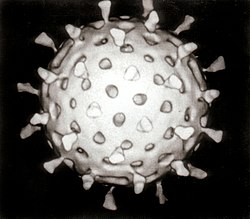
Back فيروس عجلي Arabic فيروس عجلى ARZ Ротавірусы Byelorussian Ротавируси Bulgarian রোটাভাইরাস Bengali/Bangla Rotavirus Catalan Rotavirus Czech Rotavirus German Ιός Ρότα Greek Rotavirus Spanish
| Rotavirus | |
|---|---|

| |
| Computer–aided reconstruction of a rotavirus based on several electron micrographs | |
| Virus classification | |
| (unranked): | Virus |
| Realm: | Riboviria |
| Kingdom: | Orthornavirae |
| Phylum: | Duplornaviricota |
| Class: | Resentoviricetes |
| Order: | Reovirales |
| Family: | Sedoreoviridae |
| Genus: | Rotavirus |
| Species | |
| |
Rotaviruses are the most common cause of diarrhoeal disease among infants and young children.[1] Nearly every child in the world is infected with a rotavirus at least once by the age of five.[2] Immunity develops with each infection, so subsequent infections are less severe. Adults are rarely affected.[3]
The virus is transmitted by the faecal–oral route. It infects and damages the cells that line the small intestine and causes gastroenteritis (which is often called "stomach flu" despite having no relation to influenza). Although rotavirus was discovered in 1973 by Ruth Bishop and her colleagues by electron micrograph images[4] and accounts for approximately one third of hospitalisations for severe diarrhoea in infants and children,[5] its importance has historically been underestimated within the public health community, particularly in developing countries.[6] In addition to its impact on human health, rotavirus also infects other animals, and is a pathogen of livestock.[7]
Rotaviral enteritis is usually an easily managed disease of childhood, but among children under 5 years of age rotavirus caused an estimated 151,714 deaths from diarrhoea in 2019.[8] In the United States, before initiation of the rotavirus vaccination programme in the 2000s, rotavirus caused about 2.7 million cases of severe gastroenteritis in children, almost 60,000 hospitalisations, and around 37 deaths each year.[9] Following rotavirus vaccine introduction in the United States, hospitalisation rates have fallen significantly.[10][11] Public health campaigns to combat rotavirus focus on providing oral rehydration therapy for infected children and vaccination to prevent the disease.[12] The incidence and severity of rotavirus infections has declined significantly in countries that have added rotavirus vaccine to their routine childhood immunisation policies.[13][14][15]
Rotavirus is a genus of double-stranded RNA viruses in the family Reoviridae. There are ten species of the genus, usually referred to as RVA, RVB, RVC, RVD, RVG, RVF, RVI, RVJ, RVK and RVL. The most common is RVA, and these rotaviruses cause more than 90% of rotavirus infections in humans.[16]
- ^ Dennehy PH (September 2015). "Rotavirus Infection: A Disease of the Past?". Infectious Disease Clinics of North America. 29 (4): 617–635. doi:10.1016/j.idc.2015.07.002. PMID 26337738.
- ^ Cite error: The named reference
pmid19252423was invoked but never defined (see the help page). - ^ Cite error: The named reference
pmid18838873was invoked but never defined (see the help page). - ^ Cite error: The named reference
pmid19799704was invoked but never defined (see the help page). - ^ Hallowell BD, Chavers T, Parashar U, Tate JE (April 2022). "Global Estimates of Rotavirus Hospitalizations Among Children Below 5 Years in 2019 and Current and Projected Impacts of Rotavirus Vaccination". Journal of the Pediatric Infectious Diseases Society. 11 (4): 149–158. doi:10.1093/jpids/piab114. PMC 11495151. PMID 34904636.
- ^ Simpson E, Wittet S, Bonilla J, Gamazina K, Cooley L, Winkler JL (2007). "Use of formative research in developing a knowledge translation approach to rotavirus vaccine introduction in developing countries". BMC Public Health. 7: 281. doi:10.1186/1471-2458-7-281. PMC 2173895. PMID 17919334. S2CID 424503.
- ^ Cite error: The named reference
isbn0-12-375158-6was invoked but never defined (see the help page). - ^ Janko MM, Joffe J, Michael D, Earl L, Rosettie KL, Sparks GW, Albertson SB, Compton K, Pedroza Velandia P, Stafford L, Zheng P, Aravkin A, Kyu HH, Murray CJ, Weaver MR (June 2022). "Cost-effectiveness of rotavirus vaccination in children under five years of age in 195 countries: A meta-regression analysis". Vaccine. 40 (28): 3903–3917. doi:10.1016/j.vaccine.2022.05.042. PMC 9208428. PMID 35643565. S2CID 249072461.
- ^ Fischer TK, Viboud C, Parashar U, Malek M, Steiner C, Glass R, Simonsen L (April 2007). "Hospitalizations and deaths from diarrhea and rotavirus among children <5 years of age in the United States, 1993–2003". The Journal of Infectious Diseases. 195 (8): 1117–1125. doi:10.1086/512863. PMID 17357047.
- ^ Leshem E, Moritz RE, Curns AT, Zhou F, Tate JE, Lopman BA, Parashar UD (July 2014). "Rotavirus vaccines and health care utilization for diarrhea in the United States (2007–2011)". Pediatrics. 134 (1): 15–23. doi:10.1542/peds.2013-3849. PMC 7975848. PMID 24913793.
- ^ Tate JE, Cortese MM, Payne DC, Curns AT, Yen C, Esposito DH, et al. (January 2011). "Uptake, impact, and effectiveness of rotavirus vaccination in the United States: review of the first 3 years of postlicensure data". The Pediatric Infectious Disease Journal. 30 (1 Suppl): S56–60. doi:10.1097/INF.0b013e3181fefdc0. PMID 21183842. S2CID 20940659.
- ^ Cite error: The named reference
pmid18026034was invoked but never defined (see the help page). - ^ Cite error: The named reference
pmid21734466was invoked but never defined (see the help page). - ^ Jiang V, Jiang B, Tate J, Parashar UD, Patel MM (July 2010). "Performance of rotavirus vaccines in developed and developing countries". Human Vaccines. 6 (7): 532–42. doi:10.4161/hv.6.7.11278. PMC 3322519. PMID 20622508.
- ^ Parashar UD, Johnson H, Steele AD, Tate JE (May 2016). Parashar UD, Tate JE (eds.). "Health Impact of Rotavirus Vaccination in Developing Countries: Progress and Way Forward". Clinical Infectious Diseases. 62 (Suppl 2): S91–95. doi:10.1093/cid/civ1015. PMC 11343039. PMID 27059361.
- ^ Cite error: The named reference
pmid16418157was invoked but never defined (see the help page).
© MMXXIII Rich X Search. We shall prevail. All rights reserved. Rich X Search